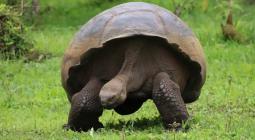Lost and found: noisy, tame and very active, Argentina delights in giant otter’s return

Decades after the world’s biggest otter disappeared from the country, a kayaking trip revealed a lone male swimming in the Bermejo River
“This really is a big animal,” says Sebastián Di Martino, conservation director of Rewilding Argentina, emphasising the “giant” in giant otter (Pteronura brasiliensis). “It can be 1.7 metres long … the biggest otter in the world.”
Until its recent rediscovery, the giant otter was feared extinct in the country as a result of habitat loss and hunting. “Family groups were last seen in the 1980s in the Misiones province of north-eastern Argentina,” Di Martino says. “In the Bermejo River, the last sightings occurred 130 years ago, in 1898.”
In May 2021, Di Martino captured a lone male giant otter on his phone while kayaking on the Bermejo River in El Impenetrable national park, in the Chaco province of north-east Argentina. It wasn’t an animal he was searching for or expecting to see. “I saw the otter by chance,” he recalls. “The first time I saw it, I was in the tent of our biological station in El Impenetrable national park, which is by a lagoon of the Bermejo River … but I wasn’t able to take a picture. Days later, I was kayaking on the lagoon and I heard something jump into the water. Then the animal made a noise, an alarm sound I know well, because we have giant otters in a pre-release pen in Iberá.” Di Martino turned the kayak around and started to film. “When the giant otter saw me, it showed the upper part of its body out of the water and I saw its white chest.”
Di Martino was overjoyed to see the remarkable animal, which can weigh more than 30kg (66lb), back in the Bermejo. “It is considered endangered worldwide by the International Union for Conservation of Nature (IUCN),” Di Martino says. “They are big predators in South America’s aquatic systems. They’re diurnal, very noisy, very tame towards people and very active, so watching them is incredibly entertaining: they never stop doing things, like coming in and out of the water. This behaviour is also why they went extinct. Most historic records of giant otters are of people shooting them from boats.”
Argentina has been working to bring giant otters back to the country since 2018, concentrating efforts in the Iberá wetlands. Di Martino’s discovery kickstarted a plan to reintroduce them to El Impenetrable, too. “After seeing giant otters in the Bermejo, we could see the river is a good habitat for this species, very connected with other waterways and likely Paraguay – the closest place where there are still wild giant otters and where this one probably came from,” Di Martino explains.
“It shows us there is still hope to connect populations we are reintroducing in Iberá, and now in El Impenetrable, with the Pantanal, [which has] one of the strongest populations of giant river otters.”
Though the male otter disappeared from Impenetrable and wasn’t seen for several months, it recently reappeared, and work has begun to build an enclosure in a lagoon by the Bermejo River.
Sofía Heinonen, biologist and director of Rewilding Argentina, says: “We know it is a male because we saw its testicles on camera-trap photos. It’s likely a young male that has dispersed from his family group to find a female. We hope this male will get anchored here at Impenetrable national park, thanks to the presence of a female that we’ll bring there from Iberá.
“The female otter was born in a pen in Iberá, so she’s a semi-wild animal. If it succeeds, we can think of releasing them and having the first wild family of giant otters here after decades of extinction.”
cover photo: An image of the giant otter captured by a camera trap. Photograph: Fundación Rewilding Argentina





